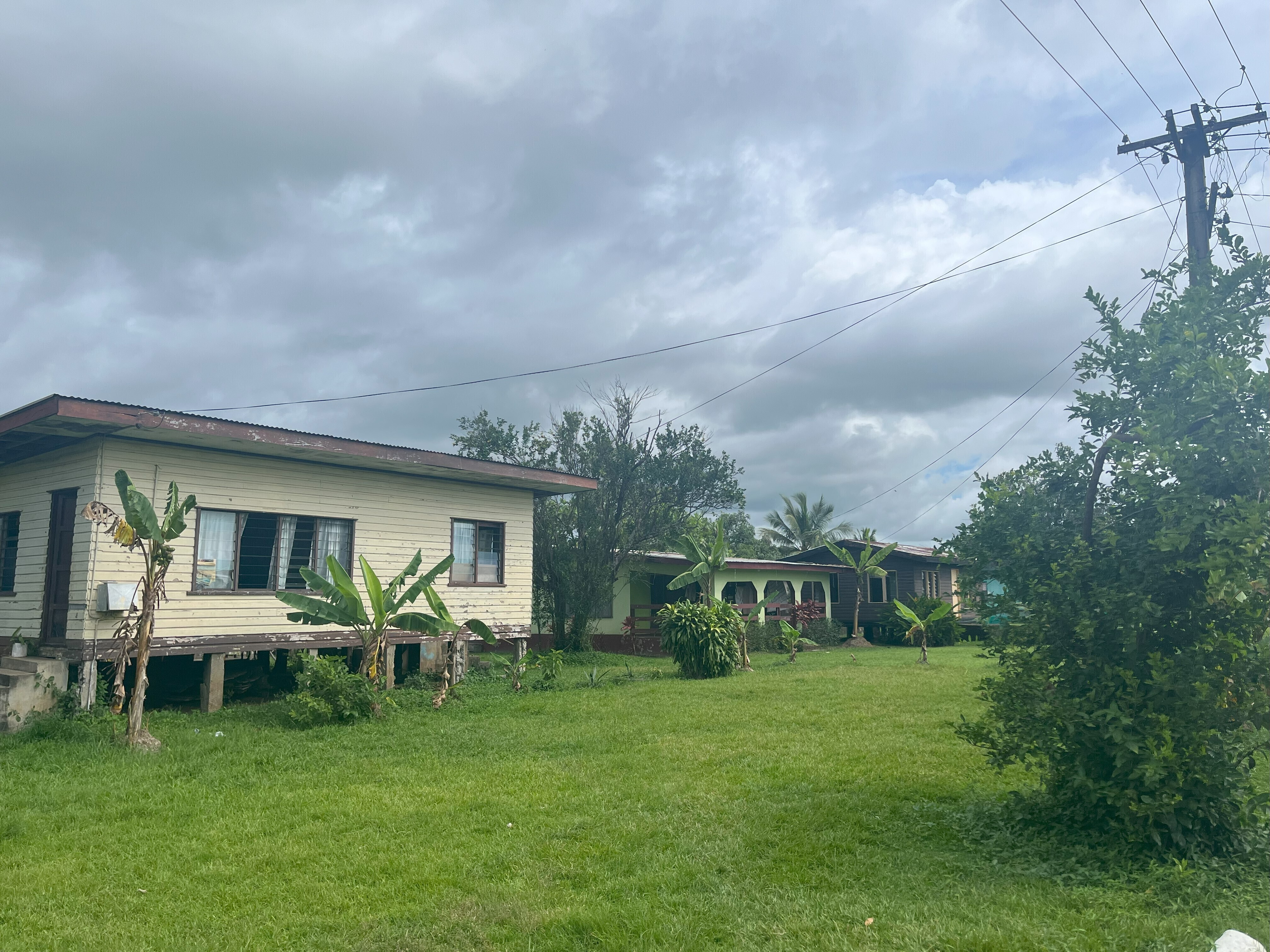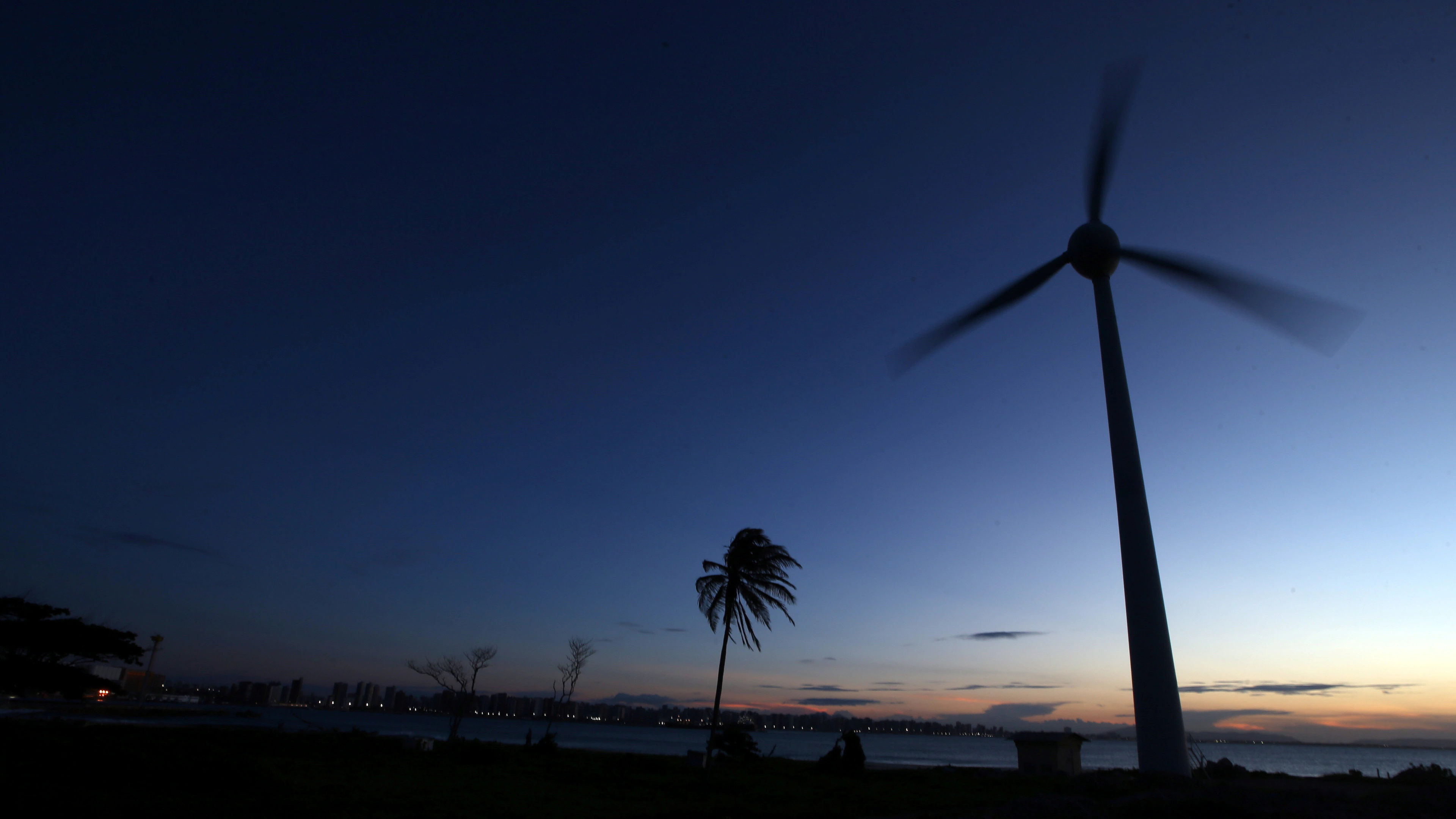The global economy is slowing - here's why that may not be such a bad thing
Transcripción del podcast
This transcript has been generated using speech recognition software and may contain errors. Please check its accuracy against the audio.
Jérôme Haegeli, Chief Economist, Swiss Re: First of all, the global economy is set to weaken. We expect advanced economies to be the weakest since the 1980s outside of the global financial crisis and the COVID crisis.
Robin Pomeroy, host, Radio Davos: Welcome to Radio Davos, the podcast from the World Economic Forum that looks at the biggest challenges and how we might face them.
This week, a look at the global economy. The World Economic Forum has just published its regular Chief Economists Outlook, which reflects the views of chief economists around the world, and most of them see the global economy slowing.
This economist tells us why that’s maybe not such a bad thing.
Jérôme Haegeli: Well, I wouldn't say it's pessimistic. Actually, growth slowing down is part of the solution of getting inflation under control. So I really do hope growth is going to slow down because if it's not going to slow down then we have a bigger problem on the inflation front
Robin Pomeroy: But haven’t we succeeded in taming runaway inflation? Perhaps, but this economist is cautious.
Jérôme Haegeli: Maybe the biggest risk out there is complacency - that we declare too early victory over inflation.
Robin Pomeroy: And looking ahead - what are the big trends that chief economists expect to shape the global economy in the medium to long term?
Jérôme Haegeli: We're looking at climate change, climate change still the number one long-term economic risk.
We're looking at globalisation, supply chain changes. Globalisation has peaked. Deglobalisation is happening, but you don't see it yet in the numbers.
Robin Pomeroy: Subscribe to Radio Davos wherever you get your podcasts, or visit wef.ch/podcasts where you will also find Meet the Leader, Agenda Dialogues and the World Economic Forum Book Club Podcast.
I’m Robin Pomeroy at the World Economic Forum, and with this look at the Chief Economists Outlook
Jérôme Haegeli: We live in a world of high risk, higher uncertainty.
Robin Pomeroy: This is Radio Davos.
This episode of Radio Davos comes to you on Day 1 of the annual Sustainable Development Impact Meetings which take place all this week from the 18th to the 22nd of September, 2023 at the World Economic Forum in New York.
Leaders from politics, business and civil society are meeting to discuss ways to achieve the UN Sustainable Development Goals, the 17 goals designed to make a better world by 2030.
You can follow the action on the website wef.ch/sdim23 and across social media using the hashtag #SDIM23.
One of several key reports published for the Sustainable Development Impact Meetings is the Chief Economists Outlook, and that's the subject of this episode.
The report, which is something the Forum does every few months, is based on the views of senior economists around the world.
This edition shows a glass half full and half empty, with concerns of widespread economic recession easing since the last report in May, but continued economic uncertainty and geopolitical tensions.
A couple of headlines from the report: most economists, 61% of those questioned, expect the global economy to weaken in the coming year. But an even bigger majority, 86%, are optimistic that inflation will ease.
You can find the whole report on our website, links in the show notes.
And joining me now to share his views on the global economy is the chief economist at insurer Swiss Re, one of the world's largest reinsurance companies.
Jérôme Haegeli, thanks for joining us. Tell us Jérôme before we start, for anyone who doesn't know: what is a chief economist at a company like yours? What do you do?
Jérôme Haegeli: Well, I look at the macroeconomic developments across the globe. I have a global team. I do the forecasts for three Swiss Re, the in-house forecasts on the macro as well as the insurance front. That's number one, including with it economic scenarios, not just looking at the baseline scenario, but also alternative scenarios. And on top of that, I do a lot of thought leadership reports. You might know the Sigma flagship report of Swiss Re, which has been running now since 56 years. And on top of that, obviously, I also speak a lot and engage with clients.
Robin Pomeroy: So let's cut to it then. How is the global economy doing? How do you see the economic growth outlook and this question of recession? Are there any specific regional differences, regions that are doing better or worse than we were expecting maybe previously in the year?
Jérôme Haegeli: Well, first of all, the global economy is set to weaken. If you look back, if you look at the we mirror window in the US, the US economy has been doing stellar, extremely strong resilience, extremely strong labour markets. But that's looking out the rear window. If we look ahead, we do expect a quite a sharp economic slowdown, including the US, including Europe and including for the global economy.
If you look at our forecasts, we expect the advanced economies to bit to be the weakest since the 1980s outside of the global financial crisis and the COVID crisis that we had seen not so long ago. That's number one.
Number two, you asked about divergence, yes, actually, there is likely going to be quite a divergence in economic growth. And emerging Asia is likely to do much better than advanced economies as well as the global economy.
If you look at our forecasts, we do expect emerging Asia to be growing at about 4% this year and next year, which is about four times higher next year than the growth that you can expect in the US and Europe. So big divergence in growth and global growth slowing down quite sharply next year.
Robin Pomeroy: Is there a particular reason that the global forecast is so pessimistic?
Jérôme Haegeli: Well, I wouldn't say it's pessimistic. Actually, growth slowing down is part of the solution of getting inflation under control. So I really do hope growth is going to slow down because if it's not going to slow down then we have a bigger problem on the inflation front than we expect right now.
Reasons for the economic slowdown is monetary policy transmission mechanism finally, probably the monetary policy rate hikes that we have seen, the rate hikes by the ECB, by the Fed, the sharpest since 40 years, they are likely to take now effect.
And on top of that, we also see pockets of vulnerability. If you think about the real estate downturn and weakening in China, but also if you look at the growth rates and momentum over the last quarter, you already see euro area which is stagnating and in the US you see still strong growth in terms of labour market. However, you also see manufacturing sector slowing down quite, quite sharply.
So there are pockets of vulnerabilities and as higher interest rates will constrain credit growth, economic growth is likely to come down further.
Robin Pomeroy: So what about inflation then? At the start of this year, there were fears that it was going to. Spiral out of control. People who remembered the 1970s. Which had the knock on effect for individuals of the cost of living crisis. Where do you see the first of those now, this idea of spiralling inflation, that seems to have come under control, you're suggesting.
Jérôme Haegeli: Yes and no. And if you look at where we are heading direction wise, yes, it's great. Headline inflation in the US in Europe is coming down quite sharply. In the US, headline inflation is now below 4%. In the euro area it's around 5%, 5% is much lower than the 10% euro inflation rate that we had seen last year. So direction-wise, it's great.
However, if you look at inflation developments over the last year or two and if you look at inflation development in the 1970s, maybe the biggest risk out there is complacency that we declare too early victory over inflation.
On the supply side front, we have seen a lot of easing. The supply side, the whole global manufacturing process, is working pretty well again - there are not so many supply side bottlenecks anymore. However, on the demand front, you still have a lot of pressure.
And this is why I really hope that and I'm pretty convinced that central banks around the globe, they will continue to run a tight monetary policy for longer. Maybe not tighter, but there is a risk of tighter monetary policy, but at least they keep policy rates higher for longer. And I think there are good reasons thereof because inflation victory, we cannot declare it yet. It's too early to declare victory over inflation.
Robin Pomeroy: There'll be political pressure, public pressure maybe for central banks to ease on those rates. So you're saying they mustn't do that and really they need to, if anything, certainly not decrease rates and probably possibly continue a bit increasing rates.
Jérôme Haegeli: Well, absolutely. First of all, absolutely not, right? If you if you don't have price stability yet, it would be way too early to decrease interest rates. And we are not at this stage.
However, the question is what will central banks do when growth weakens. And actually have a scenario of pretty sharp slowdown. If it's not a recession, the slowdown will still hurt because you'll see labour market weakening in that environment. Central banks should not ease monetary policy if they don't see that the inflation rate has come down sustainably. And we should not just look at the headline inflation rate, we should look at core inflation and developments, and they are the signs of are way too early to say that we are at this point yet where central banks could over the next quarter or to ease.
Robin Pomeroy: What is the inflation rate that the Fed and the European Central Bank should be looking at? I mean, they used to always talk about around 2% inflation and that just seemed impossible this time last year with inflation going into double figures. Is that still this kind of a sacrosanct figure, 2%?
Jérôme Haegeli: Well, you don't change the goalposts if you haven't reached the goal yet, that would be super dangerous. Central banks' biggest resource and biggest asset is their credibility and their credibility is at stake if they don't reach price stability within a certain reasonable timeframe.
We all know with hindsight it's easy. Inflation wasn't transitory like many believed in the central bank arena and also obviously in the private sector believed, and that's why it's really important to regain back price stability. Without stable prices, there cannot be sustainable growth.
So 2% no, it's not sacrosanct, but it's sacrosanct now because we are far off from the 2% inflation rate. Lower prices, it's the best ingredient what the central bank can provide for growth to be sustainable.
So I think we better get to the 2% inflation rate, have stability in prices, and then, fine, we can have a discussion of what is what is the right inflation level.
There's nothing magic about 2%. That's why you have central banks like the Swiss National Bank, my home country, the former employee of mine, they don't define price stability as a as a target of 2.0%. They define price stability prices positive above 0%, but below 2%. And that over the medium term. And I think that is a good definition.
Robin Pomeroy: What are the other impacts of higher interest rates? You work for an insurance company. There might be some things that the average person doesn't realise. I mean, what is the impact for insurers?
Jérôme Haegeli: Interest rates, that they are not negative first of all, this is really positive news.
Interest rates, nominal interest rates in Switzerland and Germany, especially in Europe, they have been negative for way too long, and negative rates are flat-out negative.
So that was an area of financial repression where the government authorities directed with the strategies, and especially also on the central bank front, to direct funds towards funding governments. So that's part of history.
Now for higher interest rates and especially positive interest rates, for insurance companies it's a real positive driver. We calculate that one percentage point increase in interest rates leads to an incredible amount of additional loss-bearing capacity or claims-bearing capacity that an insurance company can take. For profitability, higher interest rate is incredibly positive.
Let me give you one example. If you look at the US over the last two years, you had seen an interest rate increase of government bonds of almost three percentage points. For the US insurance industry that means that they can take on on the balance sheet about 40 billion of additional losses, which is what the insurance industry in the US approximately takes on just by natural catastrophe or climate change events per year.
So the power of interest rates is incredibly positive for the insurance industry, but I think also extremely positive for the economy at large.
Robin Pomeroy: So does that mean ever higher interest rates is good for the insurance sector? Where would an insurance company like to see them?
Jérôme Haegeli: Well, you have seen last year, right? I mean, last year you had seen an interest rate regime switch and we went out of the negative to extremely low interest rate environment, to a positive environment on the interest rate front. And you saw the effect on financial markets. It wasn't a positive one.
2022 was one of the worst financial market environments of all correlation of fixed income assets and equities, the correlations not being the one that historically you would have seen. Both fixed income as well as equities were under extreme pressure.
So I'm saying that because it's not just a question of the level. Yes, the level are now in positive territory and what we were used to pre global financial crisis. But it's also a question of of stability and volatility and interest rates.
So it's good hopefully now to have some stability on the interest rate from just from a changes perspective so that people and corporations and our clients and households can also plan. If you have too much volatility on the way up or on the way down, that's not good for business and that's not good for growth.
Robin Pomeroy: Sticking with the short term and the present, you mentioned the regional differences in economic growth and emerging Asia, you said, is doing so much better. Can you can you give us any more details of where the the high growth is coming from nd why? Because people have talked about China not recovering from COVID as quickly as people had forecast.
Jérôme Haegeli: True. And it's not our expectation either that China is going to grow much stronger than what we were used to pre-COVID 19. However, it's also a question of, if you look at China, a growth rate, and we are forecasting 4.8% real GDP growth in China, it's still extremely strong. It's not the five, six, seven percentage growth rates we were used to pre-crisis.
But if you look at emerging Asia, if you think about Asia, and especially emerging markets, excluding Japan, they don't have the inflation problem that we had in advanced economies. They didn't have the stimulus, which were also partly driving the inflation problem we have today. So they're in a much better starting position while also having had naturally a higher real GDP growth rate.
And that really helps. They don't have to increase monetary policy to the same extent like the ECB, like the Bank of England or like the Fed. And that's an important reason why they are growing stronger. It's not the only reason, but it's an important reason why you see that big difference, a difference of of four in terms of growth rate between emerging Asia growing around 4% this and next year and the US and euro area below 1% for the US, that's our expectation next year, and way below 1% to almost stagnation for the euro area as a whole.
Robin Pomeroy: So let's look at the medium and long term then. Are there any big changes you're seeing in the next 12 months and then beyond? A couple of things to bring to my mind, this idea of de-globalisation to some extent, or the reorganisation of supply chains, which also would impact Asia. And also big technological shifts. Is it too early to to say what the impact of this kind of the AI revolution is going to have? What are the things you're looking at in the medium and long term?
Jérôme Haegeli: We're looking at globalisation, supply chain changes. We're looking at climate change, climate change still the number one long-term economic risk.
And yes, we are looking at the effect of technology on the economies and how they develop.
Climate change, the transition, it's really important that we get that right. But if you look at climate change, if you look at supply chain reconfiguration, all these factors - AI less digitalisation less - but the big structural factors, they are again, they are more inflationary rather than deflationary.
It's more expensive right to have two or three or four supply chains. It's much more expensive in terms of production process to do just in case rather than just in time supply chain management, what we were used to.
And on the climate change front, the transition means more investments and also the weather related effects. If you think about El Nino this year, the weather related effects, it can have and it has quite a strong economic effect and also an economic effect on prices.
So that's something we are very much and closely looking at.
AI I think has the potential and technology has a potential also to to move productivity up, and it could be very positive for the supply side of the economy, but it's too early to say.
On top of that, and what's also important, I think, to look at and it's driving globalisation is is the politicisation of of the economy and maybe the industrialisation of national economies. It's a trend that we have been seeing now for for quite some time and it's intensifying coming out of post COVID.
Robin Pomeroy: Do you think that trend is here to stay or could it be could it be a transitory thing, and when companies and governments realise the costs involved of more nationalistic industrial policy, that maybe they'll gradually drift back to the status quo before?
Jérôme Haegeli: No, I think it's it's here to stay. It's rare right, as you look over economic history, over the last hundred, 200 years, when the government steps in and the role of the government becomes bigger, it's very rare that actually they retreat back.
The government needed to step in for the COVID-19 crisis, no question about that. But they are stepping in with with the politicisation of markets and deglobalisation that we are seeing. They are stepping in to such an extent which we have rarely seen, I would say, post-World War Two period.
I would say three points in terms of the trend. Number one, globalisation has peaked. Deglobalisation is happening, but you don't see it yet in the numbers.
Number two, deglobalisation likely to happen more in terms of services, I think financial services in particular, less so probably in trade.
And number three, looking ahead, yes, I do believe it's structural and this multi year, if not multi-decade process ahead of us.
And all in all, in terms of the economic effects, that's another driver why we should be careful in declaring inflation and inflation pressure to be... inflation victory to be here. It will take time for in order for inflation pressure to come down and the supply chain reconfiguration adds to the inflation pressure.
Robin Pomeroy: What about other emerging economic powers in the medium and long term? India and Africa? India seems to be forging ahead.
Jérôme Haegeli: India is super interesting. And you have seen the G20 meetings recently. And in the G20 meetings I found it really interesting the announcement of of new infrastructure investments by India, by the euro area, and by the US. You see that we are not living in a in a bipolar political world. We are living in a multi-polar world and it's good to see more investment in infrastructure and it's good to see what we have been seeing out of the G20 meeting, even though it shows that still there are fractions and there are tensions, global political tensions. No question about that.
Robin Pomeroy: We've got a couple of minutes left. Are there things you think we should be looking at in the last few minutes?
Jérôme Haegeli: We discussed it at the beginning higher interest rates, are they here to stay? Yes, they're here to stay. And what does it mean for the economy? I think it's really positive to see higher interest rates. Why? Number one, finally, there is again a return of capital being invested. Number two, you need higher interest rates for the allocation of risk. It's all about pricing risk. And I think about financial markets, but also the real economy. And number three, having positive interest rate. It's good for the savings industry, it's good for households, good for for pension, it's good for insurance companies. So that's that's a real positive.
Let me maybe touch one more point on on the power of interest rates for insurance companies. Yes, higher interest rates makes the business the new business more profitable. This is good for shareholders, no question about that. But it's also good for the wider economy because it means insurance companies, they can also provide more protection, protection in terms of additional insurance and to to risk like mortality, like health or also nat cat [natural catastrophes], which is very much at the forefront.
And I think, Robin, we live in a world of high risk, higher uncertainty. Yes, global growth is coming down and it's good at least that that part of disfunction that we had over the last 15 years, negative rates, is something of the past. And I don't think we're going to be revisit ot anytime soon.
Robin Pomeroy: Jérôme Haegeli is Chief Economist at Swiss Re.
You can find the Chief Economists Outlook, and more analysis of its findings, on the World Economic Forum’s website. And you can follow the action, live or on catchup, from the Sustainable Development Impact Meetings at wef.ch/sdim23 and across social media using the hashtag #SDIM23.
Please subscribe to Radio Davos wherever you get your podcasts and leave us a rating or review. And join the conversation on the World Economic Forum Podcast Club on Facebook.
This episode of Radio Davos was written and presented by me, Robin Pomeroy. Studio production was by Gareth Nolan.
We will be back next week with more insights about the world’s biggest challenges and how we can tackle them, but for now thanks to you for listening and goodbye.
Scroll down for full podcast transcript.
The World Economic Forum has just published its latest Chief Economists Outlook, a regular report based on the views of senior economists around the world.
This edition shows a glass half full and half empty, with concerns of widespread economic recession easing since the last report in May, but slowing global growth and continued economic uncertainty and geopolitical tensions.
In this episode, Jérôme Haegeli, chief economist at Swiss Re, gives his views on the state of the global economy, and where things may be heading.
Read more:
Related episodes:
May 2023: Recession fears recede, but inflation's still a big risk - 3 chief economists on the global outlook
Find all our audio at: wef.ch/podcasts
Join the World Economic Forum Podcast Club
Join the World Economic Forum Book Club
Más episodios:
La Agenda Semanal
Una actualización semanal de los temas más importantes de la agenda global
Más sobre Geo-economía y PolíticaVer todo
Isabel Cane and Rob Strayer
2 de diciembre de 2025










